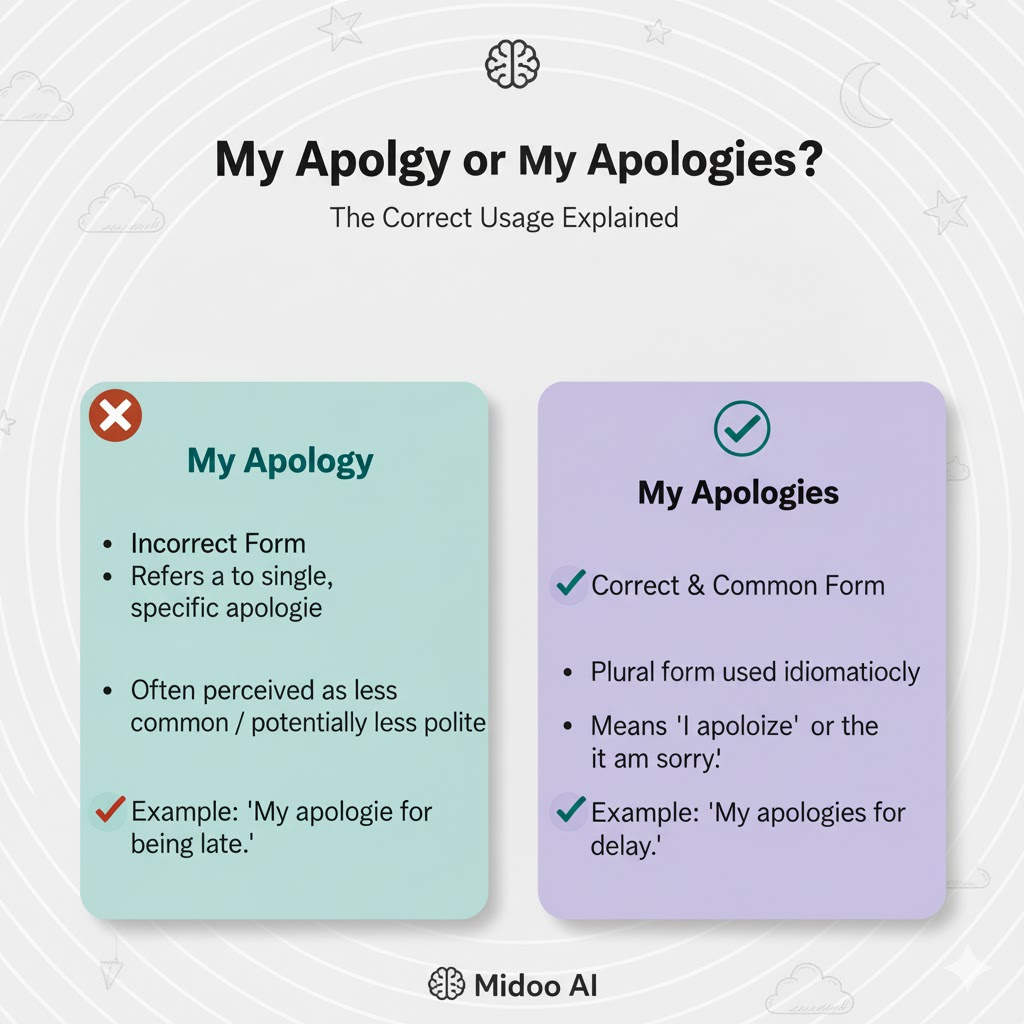“My Apology” or “My Apologies”? What’s the Correct Expression?

English learners often struggle with small but important distinctions—like when to say “my apology” versus “my apologies.”
At Midoo AI, we help learners understand these subtle differences that make English sound natural and confident. Although both forms are grammatically correct, they are used differently in everyday English. Let’s explore how to use each phrase correctly—and never sound awkward again.
1. Core Difference
- My apology → Refers to a single act of apologizing (a noun describing an event or statement).
- My apologies → An idiomatic phrase meaning “I’m sorry”, used to express regret politely.
Think of “my apology” as something you give, while “my apologies” is something you say.
2. Meaning and Usage Explained
“My Apology”
This phrase describes the act or instance of apologizing. It’s more formal and less conversational.
✅ Examples:
- I sent my apology letter to the client.
- The mayor issued his apology after the incident.
- Please accept my apology for the misunderstanding.
Here, “my apology” functions like “my explanation” or “my statement.” You’re referring to the apology itself, not directly expressing regret.
“My Apologies”
This version is what most native speakers use in everyday or professional communication. It’s polite, direct, and equivalent to saying “I’m sorry.”
✅ Examples:
- My apologies for being late.
- My apologies—I didn’t realize you were waiting.
- My apologies for the confusion in my last email.
Even though “apologies” is plural, it’s an idiom—you don’t need to be apologizing for multiple things to use it.
3. Grammar Snapshot
| Form | Type | Meaning | Tone | Common Use |
|---|---|---|---|---|
| My Apology | Noun phrase | A specific act of apologizing | Formal, detached | Less common |
| My Apologies | Fixed idiom | “I’m sorry” | Polite, natural | Very common |
4. Example + Tip Section
Example 1:
❌ My apology for being late to the meeting.
✅ My apologies for being late to the meeting.
💡 Tip: When expressing regret directly, always use “my apologies.” The singular form sounds too stiff or robotic in daily communication.
Example 2:
The CEO issued an apology for the delay.
The CEO sent his apologies to the media.
💡 Tip:
Use “an apology” / “my apology” when referring to the act itself.
Use “my apologies” when saying sorry directly to someone.
Example 3:
My apologies if this caused any trouble.
My apology was accepted by everyone involved.
💡 Tip:
When unsure, default to “my apologies.” It fits in emails, meetings, and conversations naturally.
5. Common Mistakes to Avoid
🚫 “My apology for the mistake.” → Sounds unnatural in most contexts.
✅ “My apologies for the mistake.”
🚫 “I offer my apology for the delay.” → Grammatically fine but overly formal.
✅ “My apologies for the delay—thank you for your patience.”
🚫 “Please accept my apology.” → Acceptable only if you’re referring to the apology as a document or act.
💡 Midoo Tip: Think about intent.
If you’re describing the act of apologizing, use my apology.
If you’re actually apologizing, use my apologies.
6. Quick Comparison Summary
| Usage Context | Correct Form | Example |
|---|---|---|
| Expressing regret | My apologies | My apologies for being late. |
| Describing a formal apology | My apology | He accepted my apology. |
| In formal writing | Both (depending on tone) | Please accept my apology / apologies. |
| In casual speech | My apologies | My apologies! Didn’t mean to interrupt. |